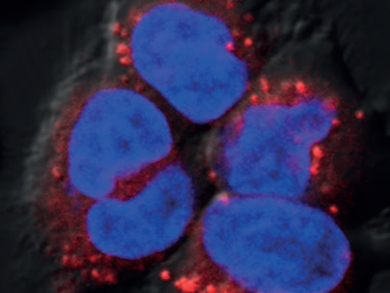Fluorophore materials are used in molecule markers, electronic devices, and sensor technologies. Peter Karuso, Macquarie University, Sydney, Australia, Xavier Franck, University of Rouen, France, and colleagues have designed and synthesized hybrid fluorescent materials based on an epicocconone skeleton (the compound responsible for fluorescence in the fungus Epicoccum nigrum) and hemicyanines (a common class of NIR dye materials).
By combining an epicocconone derivative with different hemicyanine derivatives, the team made a range of materials with an increased number of conjugated double bonds compared to the parent epicocconone. The products were tested using a fluorescence spectrophotometer, as well as in protein staining and cell imaging applications.
All the dyes displayed near-infrared fluorescence maxima in the range of 715–795 nm and large Stokes shifts of up to 95 nm. The absorption and emission wavelengths can be modulated by varying the hemicyanine moiety. One of the synthesized dyes gave a clean staining in sodium dodecyl sulfate (SDS) gels (used to separate proteins) with bovine serum albumin. It has a detection limit of 220 pg of protein and is more sensitive than commercially available stains. According to the researchers, the developed hybrid dyes could be useful NIR probes for chemical biology.
- Epicocconone-Hemicyanine Hybrids: Near Infrared Fluorophores for Protein Staining and Cell Imaging,
Peter Karuso, Wendy Loa Kum Cheung, Philippe A. Peixoto, Agathe Boulangé, Xavier Franck,
Chem. Eur. J. 2016.
DOI: 10.1002/chem.201604698




